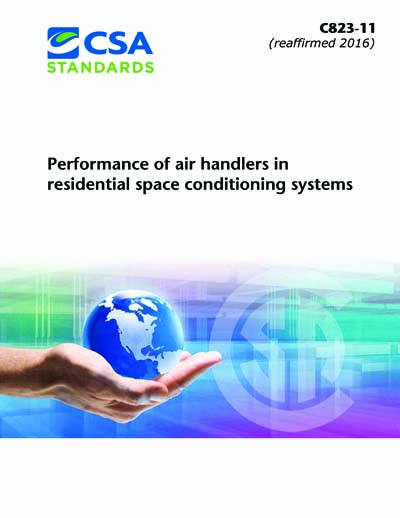Most recent
CSA C823-11 (R2021)
Performance of air handlers in residential space conditioning systems
Preface This is the first edition of CSA C823, Performance of air handlers in residential space conditioning systems. This Standard specifies requirements for measuring both the air delivery and the electrical energy consumption of air handlers in residential space conditioning systems over a range of static pressures and speed control settings. Based on those measurements, performance ratings are developed for air handlers for each of their operating control settings using a standardized system resistance curve. An annual electrical energy consumption rating is also calculated. The actual performance and annual electricity use of air handlers can vary from the ratings because of differences in how they are installed and used. Figures 1 to 3 have been adapted from ANSI/AMCA 210-07, with permission. CSA acknowledges that the development of this Standard was made possible, in part, by the financial support of BC Hydro, the Canadian Electricity Association (CEA), Manitoba Hydro, Natural Resources Canada (NRCan), the Ontario Ministry of Energy (OME), the Ontario Power Authority (OPA), and SaskPower. This Standard has been developed in compliance with Standards Council of Canada requirements for National Standards of Canada. It has been published as a National Standard of Canada by CSA Group. Scope 1.1 This Standard applies to ducted air handler units that are used to supply and/or circulate conditioned air in residential central space conditioning systems such as furnaces, heat pumps, combination air handlers, and fan coils. 1.2 This Standard specifies the test procedure and calculations for determining performance ratings for the air delivery and electrical energy consumption of air handlers. It does not address thermal performance ratings for air handler systems. 1.3 This Standard does not apply to draft inducer fans, exhaust fans, or heat/energy recovery ventilators. 1.4 In CSA standards, "shall" is used to express a requirement, i.e., a provision that the user is obliged to satisfy in order to comply with the standard; "should" is used to express a recommendation or that which is advised but not required; and "may" is used to express an option or that which is permissible within the limits of the standard. Notes accompanying clauses do not include requirements or alternative requirements; the purpose of a note accompanying a clause is to separate from the text explanatory or informative material. Notes to tables and figures are considered part of the table or figure and may be written as requirements. Annexes are designated normative (mandatory) or informative (nonmandatory) to define their application. 1.5 The values given in SI units are the units of record for the purposes of this Standard. The values given in parentheses are for information and comparison only.
Content Provider
CSA America, Inc. [csa]






